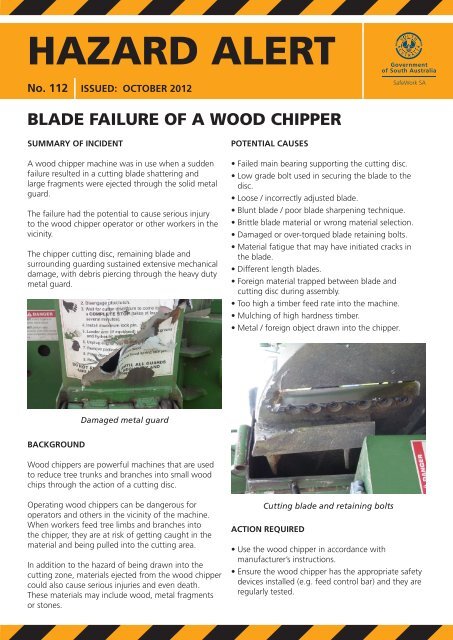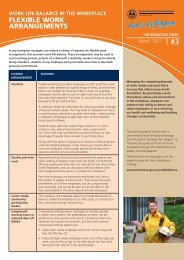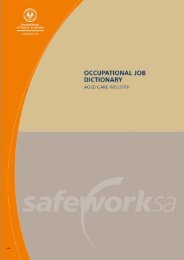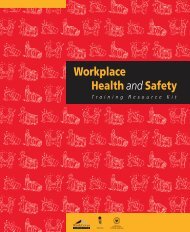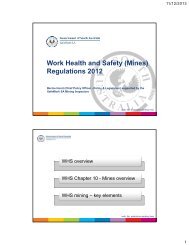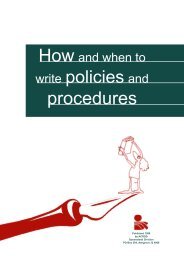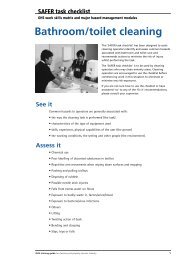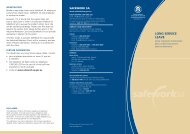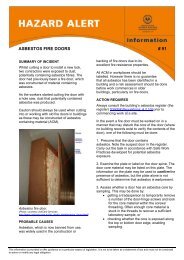Hazard Alert No 112 Blade failure of a wood chipper - SafeWork SA ...
Hazard Alert No 112 Blade failure of a wood chipper - SafeWork SA ...
Hazard Alert No 112 Blade failure of a wood chipper - SafeWork SA ...
Create successful ePaper yourself
Turn your PDF publications into a flip-book with our unique Google optimized e-Paper software.
HAZARD ALERT<br />
<strong>No</strong>. <strong>112</strong> ISSUED: OCTOBER 2012<br />
BLADE FAILURE OF A WOOD CHIPPER<br />
SUMMARY OF INCIDENT<br />
A <strong>wood</strong> <strong>chipper</strong> machine was in use when a sudden<br />
<strong>failure</strong> resulted in a cutting blade shattering and<br />
large fragments were ejected through the solid metal<br />
guard.<br />
The <strong>failure</strong> had the potential to cause serious injury<br />
to the <strong>wood</strong> <strong>chipper</strong> operator or other workers in the<br />
vicinity.<br />
The <strong>chipper</strong> cutting disc, remaining blade and<br />
surrounding guarding sustained extensive mechanical<br />
damage, with debris piercing through the heavy duty<br />
metal guard.<br />
BACKGROUND<br />
Damaged metal guard<br />
Wood <strong>chipper</strong>s are powerful machines that are used<br />
to reduce tree trunks and branches into small <strong>wood</strong><br />
chips through the action <strong>of</strong> a cutting disc.<br />
Operating <strong>wood</strong> <strong>chipper</strong>s can be dangerous for<br />
operators and others in the vicinity <strong>of</strong> the machine.<br />
When workers feed tree limbs and branches into<br />
the <strong>chipper</strong>, they are at risk <strong>of</strong> getting caught in the<br />
material and being pulled into the cutting area.<br />
In addition to the hazard <strong>of</strong> being drawn into the<br />
cutting zone, materials ejected from the <strong>wood</strong> <strong>chipper</strong><br />
could also cause serious injuries and even death.<br />
These materials may include <strong>wood</strong>, metal fragments<br />
or stones.<br />
POTENTIAL CAUSES<br />
• Failed main bearing supporting the cutting disc.<br />
• Low grade bolt used in securing the blade to the<br />
disc.<br />
• Loose / incorrectly adjusted blade.<br />
• Blunt blade / poor blade sharpening technique.<br />
• Brittle blade material or wrong material selection.<br />
• Damaged or over-torqued blade retaining bolts.<br />
• Material fatigue that may have initiated cracks in<br />
the blade.<br />
• Different length blades.<br />
• Foreign material trapped between blade and<br />
cutting disc during assembly.<br />
• Too high a timber feed rate into the machine.<br />
• Mulching <strong>of</strong> high hardness timber.<br />
• Metal / foreign object drawn into the <strong>chipper</strong>.<br />
Cutting blade and retaining bolts<br />
ACTION REQUIRED<br />
• Use the <strong>wood</strong> <strong>chipper</strong> in accordance with<br />
manufacturer’s instructions.<br />
• Ensure the <strong>wood</strong> <strong>chipper</strong> has the appropriate safety<br />
devices installed (e.g. feed control bar) and they are<br />
regularly tested.
- 2 -<br />
The manufacturer <strong>of</strong> the “Super Axe” has developed a that any axe blade control systems are properly labelled and<br />
modification • Check the that condition includes <strong>of</strong> a double blades action prior to to startup, interlock the cannot be inadvertently activated.<br />
blade including control, minimising the securing unintended bolts. operation.<br />
• Ensure workers wear the appropriate Personal All operators should be trained in the operation <strong>of</strong> log<br />
Install Protective the modification Equipment provided (PPE). by the manufacturer. splitting machines.<br />
• All repairs/servicing must be done by competent Safety Procedures should include a system <strong>of</strong> work<br />
Owners persons. and operators <strong>of</strong> machines with a similar operating to shutdown or isolate the axe control system before<br />
mechanism<br />
• Establish<br />
should<br />
a regular<br />
check<br />
servicing,<br />
their machines<br />
maintenance<br />
to see if<br />
and<br />
similar attempting to free a log stuck on the axe blade.<br />
modifications<br />
inspection<br />
are<br />
program.<br />
required.<br />
Repair or replace faulty parts<br />
as identified from inspection.<br />
Safety procedures should be regularly monitored and<br />
Owners and operators <strong>of</strong> log splitters should make sure reinforced<br />
• Ensure that a hazardous work zone is appropriately<br />
that any axe blade control systems are properly labelled and<br />
identified to exclude members <strong>of</strong> the public and<br />
cannot be inadvertently activated.<br />
FURTHER INFORMATION<br />
non-essential workers.<br />
For further information please contact:<br />
All operators should be trained in the operation <strong>of</strong> log<br />
splitting machines.<br />
<strong>SafeWork</strong> <strong>SA</strong><br />
GPO Box 465<br />
ADELAIDE <strong>SA</strong> 5001<br />
Safety Procedures should include a system <strong>of</strong> work<br />
to shutdown or isolate the axe control system before<br />
attempting to free a log stuck on the axe blade.<br />
Safety procedures should be regularly monitored and<br />
reinforced<br />
This incident may be unique to the leg operated axe control<br />
<strong>of</strong> the Whitlands Engineering “Super Axe”<br />
A stirrup fits around the operator’s upper right leg, with<br />
movement <strong>of</strong> the leg causing the axe blade to either raise<br />
or lower.<br />
When a log stuck on the axe blade, the operator used<br />
both hands try and lever the log <strong>of</strong>f the axe blade, as<br />
the operator moved, the machine accidentally operated,<br />
crushing three fingers <strong>of</strong> the worker’s left hand between<br />
the log and the machine table.<br />
ACTION REQUIRED<br />
The manufacturer <strong>of</strong> the “Super Axe” has developed a<br />
modification that includes a double action to interlock the<br />
blade control, minimising unintended operation.<br />
Install the modification provided by the manufacturer.<br />
Owners and operators <strong>of</strong> machines with a similar operating<br />
mechanism should check their machines to see if similar<br />
modifications are required.<br />
Issued: October 2012<br />
Owners Review: and operators October 2014<br />
<strong>of</strong> log splitters should make sure<br />
CONTACT DETAILS<br />
Country Offices<br />
Berri, Mount Gambier, Port Lincoln, Port Pirie and Whyalla<br />
Help Centre<br />
Library and Bookshop<br />
100 Waymouth Street, Adelaide<br />
Telephone: 1300 365 255<br />
Website: www.safework.sa.gov.au<br />
Issued: July 2011<br />
Review: July 2013<br />
<strong>SafeWork</strong> <strong>SA</strong>: GPO Box 465, ADELAIDE <strong>SA</strong> 5001<br />
Country <strong>of</strong>fices: Berri, Mount Gambier, Port Lincoln, Port Pirie and Whyalla<br />
Library and Bookshop: Ground floor, State Administration Centre<br />
200 Victoria Square, Adelaide<br />
Help Centre: 1300 365 255<br />
www.safework.sa.gov.au<br />
This information is provided to <strong>of</strong>fer<br />
guidance on a particular aspect <strong>of</strong><br />
legislation. It is not to be taken as a<br />
statement <strong>of</strong> law and must not be<br />
construed to waive or modify any<br />
legal obligation.


